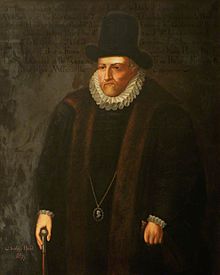Sir John Fortescue (ca. 1531 or 1533 – 23 December 1607) of Salden Manor, near Mursley, Buckinghamshire, was the seventh Chancellor of the Exchequer of England, serving from 1589 until 1603.
Origins
Fortescue was the son of Adrian Fortescue who was martyred and has been beatified. Sir John was a great-grandson of Sir Geoffrey Boleyn, Lord Mayor of London (1457), and thus a second-cousin of Queen Elizabeth I.[1] His mother was Anne Reade, daughter of Sir William Reade.[1] He was descended from Sir Richard Fortescue, 3rd son of Sir John Fortescue (died after 1432), Captain of the Castle of Meaux, of Shepham in the parish of Modbury, Devon.[2]
Career
Fortescue led a largely undistinguished career in Parliament prior to his accession to the chancellorship, serving in several districts (including for Wallingford), and he continued to serve in Parliament after losing that title. Fortescue also held the position of Chancellor of the Duchy of Lancaster from 1601 to his death. Fortescue served under Queen Elizabeth I and was knighted in 1592. He inherited the manor of Great Washbourne from his mother. [3]
When King James I came to the throne in 1603, Fortescue advocated restrictions on his power, in part in order to limit the appointment of Scottish people. These reforms were not implemented, and as a result, James dismissed him from his position as Chancellor of the Exchequer. He retained, however, his position in Parliament and as Chancellor of the Duchy of Lancaster, as well as the keeper of the great wardrobe.[4]
Death and burial
Fortescue was buried in Mursley Church in Buckinghamshire, where a monument was erected in his honour.[5]
Family
Fortescue had six children with his first wife Cecilia Ashfield (d. 1571), daughter of Sir Edmund Ashfield of Ewelme.[6] Including:
- Francis Fortescue (1563-1624), who married in 1589 Grace Manners (d. 1624), daughter of Sir John Manners of Haddon Hall, second son of Thomas Earl of Rutland, and of Dorothy Vernon daughter and co-heir of Sir George Vernon. A daughter, Dorothy Vernon (d. 1650), married Sir Robert Throckmorton of Weston-Underwood and Coughton Court.
- William Fortescue of Salden (1562-1629).[7]
- Eleanor Fortescue (1579-1605), who married (1) in 1585, Valentine Piggot (2) Edward Hobart.
He had a daughter with seventh with his second wife, Alice Smith, daughter of Christopher Smith of Annables, Hertfordshire, and widow of Richard Robson:
- Margery Fortescue (d. 1613), who married Sir John Pulteney of Misterton, Leicestershire (1585-1617).[8]
Many of his children followed his path in politics, holding positions in Parliament.[5] In 1621 Alice Fortescue, the widow of John Fortescue, sold Tickford Priory in Newport Pagnell to the royal physician, Dr Henry Atkins for £4,500.[9]
The house he built at Salden was demolished. A chair carved with the Fortescue and Ashfield heraldry, presumably from the house, was found in an antique shop in Aylesbury in 1873 and bought by a descendant, Thomas Fortescue, 1st Baron Clermont.[10]
References
- ^ a b http://www.tudorplace.com.ar/FORTESCUE.htm#Adrian FORTESCUE of Salden (Sir Knight)
- ^ Vivian, Lt.Col. J.L., (Ed.) The Visitations of the County of Devon: Comprising the Heralds' Visitations of 1531, 1564 & 1620, Exeter, 1895, pp.352-3
- ^ Elrington, C R. "Parishes: Great Washbourne Pages 232-237 A History of the County of Gloucester: Volume 6. Originally published by Victoria County History, London, 1965". British History Online. Retrieved 2 August 2020.
- ^ Chisholm, Hugh, ed. (1911). . Encyclopædia Britannica. 10 (11th ed.). Cambridge University Press. p. 678.
- ^ a b Sir John Fortescue of Salden by Jorge H. Castelli, accessed 16 July 2006
- ^ Virginia C.D. Moseley & Rosemary Sgroi, 'FORTESCUE, Sir John (c.1533-1607), of Salden House, Mursley, Bucks.', The History of Parliament: the House of Commons 1604-1629, ed. Andrew Thrush and John P. Ferris, 2010.
- ^ Virginia C.D. Moseley & Rosemary Sgroi, 'FORTESCUE, Sir William (c.1562-1629), of Salden House, Mursley, Bucks.; Westminster and Clerkenwell', The History of Parliament: the House of Commons 1604-1629, ed. Andrew Thrush and John P. Ferris, 2010.
- ^ Rosemary Sgroi, 'PULTENEY, Sir John (1585-1617), of Misterton, Leics.', The History of Parliament: the House of Commons 1604-1629, ed. Andrew Thrush and John P. Ferris, 2010.
- ^ Thomas Fortescue, 1st Baron Clermont, Works of Sir John Fortescue, vol. 2 (London 1869), p. 288.
- ^ Records of Buckinghamshire, vol. 4, p. 186.
| Political offices | ||
|---|---|---|
| Preceded by Walter Mildmay | Chancellor of the Exchequer 1589–1603 | Succeeded by George Home |
| Preceded by Arthur Grey | Custos Rotulorum of Buckinghamshire 1594–1600 | Succeeded by Francis Fortescue |
| Preceded by Robert Cecil | Chancellor of the Duchy of Lancaster 1601–1607 | Succeeded by Sir Thomas Parry |
| Parliament of England | ||
| Preceded by Francis Goodwin John Borlase | Member of Parliament for Buckinghamshire 1588–1598 With: Thomas Tasburgh 1588–1589 Sir Robert Dormer 1593 Francis Goodwin1597–1598 | Succeeded by Francis Fortescue Alexander Hampden |
| Preceded by Sir Robert Wroth Sir John Peyton | Member of Parliament for Middlesex 1601 With: Sir Robert Wroth | Succeeded by Sir Robert Wroth Sir W. Fleetwood |
